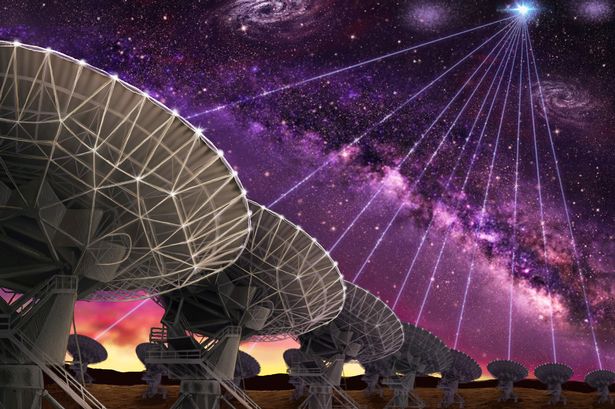एउटा प्रश्नले हजारौं वर्षदेखि मानवतालाई सताएको छ: के हामी ब्रह्माण्डमा एक्लै छौं?अहिलेसम्म कुनै जवाफ छैन, तर पत्ता लगाउने सबैभन्दा राम्रो तरिका प्राविधिक हस्ताक्षरहरू, वा प्रविधिको प्रमाण पत्ता लगाउनु हो, जुन विदेशी सभ्यताहरू विकसित भएको हुन सक्छ।समस्या एउटै हो कि खगोलविद्हरूले सधैं सम्भावित एक्स्ट्राटेरेस्ट्रियल सिग्नलहरू र मानव-कारण भएकाहरू बीचको भिन्नता पत्ता लगाउन संघर्ष गरेका छन् - अहिले सम्म।नयाँ आर्टिफिसियल इन्टेलिजेन्स-प्रशिक्षित एल्गोरिथ्मको कारण अब आठ रहस्यमय रेडियो सिग्नलहरू फेला परेका छन् जुन अन्वेषकहरूले आशा गरेका छन् कि एलियनहरूको खोजीलाई सुव्यवस्थित बनाउनेछ। टोरन्टो विश्वविद्यालयका विद्यार्थी पिटर माको नेतृत्वमा विशेषज्ञहरूले अन्तरिक्षको क्षेत्रमा ८२० ताराहरू हेर्नको लागि एल्गोरिदम प्रयोग गरेपछि रोमाञ्चक खोज गरे। पहिले कुनै पनि सम्भावित बाह्य गतिविधिबाट रहित मानिएको थियो।डाटाको अघिल्लो परीक्षाहरूमा अस्थायी संकेतहरू छुटेका थिए।मा बताउँछन्, यसको कारणको एक अंश यो हो कि 'हाम्रा धेरै अवलोकनहरूमा धेरै हस्तक्षेप छ।हामीले अन्तरिक्षमा भएका रोमाञ्चक रेडियो संकेतहरूलाई पृथ्वीबाट निस्कने चासोरहित रेडियो सङ्केतहरूबाट छुट्याउन आवश्यक छ।SETI संस्थानका खगोलविद्हरूसँगै, Breakthrough Listen र विश्वभरका वैज्ञानिक अनुसन्धान संस्थाहरू Ma ले एउटा नयाँ मेसिन लर्निङ एल्गोरिदमको विकास गर्यो जसले हाम्रो ग्रहमा भएका सबै पृष्ठभूमि आवाजहरूबाट सम्भावित एलियन सङ्केतहरू अझ राम्रोसँग छान्न सक्छ।यसमा गहिरो सिकाइ एक प्रकारको मेसिन लर्निङ र कृत्रिम बुद्धिमत्ता प्रयोग गर्ने समावेश छ जसले मानिसहरूले निश्चित प्रकारको ज्ञान प्राप्त गर्ने तरिकाको अनुकरण गर्दछ र चालकविहीन कारहरूमा मुख्य प्रविधि हो।यस अवस्थामा, अन्वेषकहरूले अनिवार्य रूपमा थप आधारभूत कम्प्युटरबाट क्लासिक एल्गोरिदम लिए र सम्भावित विदेशी संकेतहरू र मानव-कारण भएकाहरू बीचको भिन्नता सिकाउन मेसिन लर्निङ प्रयोग गरे।अवस्थित एल्गोरिथ्मले पश्चिम भर्जिनियामा रोबर्ट सी. ब्यर्ड ग्रीन बैंक टेलिस्कोपद्वारा सङ्कलन गरिएका ताराहरूको चयनबाट रेडियो डेटा खोज्दा केही पनि फेला परेन।यद्यपि, अन्तरिक्षको त्यो क्षेत्रमा चासोको विषय नभएको सट्टा, मा र उनका सहकर्मीहरूले अहिले त्यहाँबाट आउने गरी आठवटा विभिन्न रेडियो सिग्नलहरू पत्ता लगाएका छन्। स्टीव क्रफ्ट, ग्रीन बैंक टेलिस्कोपमा ब्रेकथ्रु सुन्ने परियोजना वैज्ञानिकले थपे ,कुनै पनि प्राविधिक हस्ताक्षर खोजको साथ प्रमुख मुद्दा यो एलियन्स संसारबाट प्रसारण हुन सक्ने संकेतहरू फेला पार्नको लागि यो हेर्दै छ।हाम्रा टेलिस्कोपहरूले पत्ता लगाएका धेरैजसो संकेतहरू हाम्रो आफ्नै प्रविधिबाट उत्पन्न हुन्छन्: जस्तै GPS उपग्रहहरू, मोबाइल फोनहरू।आठ संकेतहरू ३० देखि ९० प्रकाश-वर्ष टाढाको ८२० ताराहरूको सङ्कलनमध्ये पाँचको दिशाबाट उत्पन्न भएको देखिन्छ।एक्स्ट्राटेरेस्ट्रियल साबित नभए पनि, तिनीहरू कहिल्यै कम रोचक भने भएनन् ।यो अनुसन्धान नेचर एस्ट्रोनमी जर्नलमा प्रकाशित भएको छ l
One question has troubled humanity for thousands of years: are we alone in the universe?
As yet there is still no answer, but the best way of finding out is to detect technosignatures, or evidence of technology, that alien civilisations may have developed.
The only problem is that astronomers have always struggled to differentiate between potential extraterrestrial signals and human-caused ones — until now.
Eight mysterious radio signals have now been discovered thanks to a new artificial intelligence-trained algorithm that researchers hope will streamline the search for aliens.
Experts led by University of Toronto student Peter Ma made the exciting discovery after using the algorithm to look at 820 stars in an area of space previously thought to be devoid of any potential extraterrestrial activity.
The tentative signals had been missed in earlier examinations of the data.
Part of the reason for this, Ma explains, is that 'in many of our observations, there is a lot of interference.
'We need to distinguish the exciting radio signals in space from the uninteresting radio signals from Earth.'
Along with astronomers from the SETI Institute, Breakthrough Listen and scientific research institutions around the world, Ma developed a new machine learning algorithm that can better pick out potential alien signals from all the background noise on our planet.
It involved using deep learning — a type of machine learning and artificial intelligence that imitates the way humans gain certain types of knowledge and is a key technology in driverless cars.
In this case, the researchers essentially took a classic algorithm from a more basic computer and used machine learning to teach it to differentiate between potential alien signals and human-caused ones.
The existing algorithm had previously found nothing when it searched radio data from a selection of stars collected by the Robert C. Byrd Green Bank Telescope in West Virginia.
However, rather than there being nothing of interest in that area of space, Ma and his colleagues have now discovered as many as eight different radio signals coming from it.
Steve Croft, a project scientist for Breakthrough Listen on the Green Bank Telescope, added: 'The key issue with any technosignature search is looking through this huge haystack of signals to find the needle that might be a transmission from an alien world.
'The vast majority of the signals detected by our telescopes originate from our own technology: GPS satellites, mobile phones and the like.
'Peter's algorithm gives us a more effective way to filter the haystack and find signals that have the characteristics we expect from technosignatures.'
The eight signals appear to originate from the direction of five of the collection of 820 stars, which range from 30 to 90 light-years away.
While not proven to be extraterrestrial, they are never-the-less interesting.
The signals look like what scientists expect extraterrestrial signals would likely be like.
Firstly, they were narrow band — which points to an extraterrestrial source because signals caused by natural phenomena tend to be broadband.
They also had what is known as a 'slope', meaning the signals' origin had some relative acceleration with our antennas, so could not have come from Earth.
And finally, they appeared in ON-source observations rather than OFF-source ones, whereas human radio interference usually occurs in both ON and OFF observations due to the source being close by.
Croft added: 'First, they are present when we look at the star and absent when we look away, as opposed to local interference, which is generally always present.
'Second, the signals change in frequency over time in a way that makes them appear far from the telescope.'



प्रतिकृयाहरु